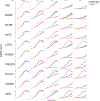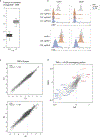Base-editing mutagenesis maps alleles to tune human T cell functions
- PMID: 38093011
- PMCID: PMC11065414
- DOI: 10.1038/s41586-023-06835-6
Base-editing mutagenesis maps alleles to tune human T cell functions
Abstract
CRISPR-enabled screening is a powerful tool for the discovery of genes that control T cell function and has nominated candidate targets for immunotherapies1-6. However, new approaches are required to probe specific nucleotide sequences within key genes. Systematic mutagenesis in primary human T cells could reveal alleles that tune specific phenotypes. DNA base editors are powerful tools for introducing targeted mutations with high efficiency7,8. Here we develop a large-scale base-editing mutagenesis platform with the goal of pinpointing nucleotides that encode amino acid residues that tune primary human T cell activation responses. We generated a library of around 117,000 single guide RNA molecules targeting base editors to protein-coding sites across 385 genes implicated in T cell function and systematically identified protein domains and specific amino acid residues that regulate T cell activation and cytokine production. We found a broad spectrum of alleles with variants encoding critical residues in proteins including PIK3CD, VAV1, LCP2, PLCG1 and DGKZ, including both gain-of-function and loss-of-function mutations. We validated the functional effects of many alleles and further demonstrated that base-editing hits could positively and negatively tune T cell cytotoxic function. Finally, higher-resolution screening using a base editor with relaxed protospacer-adjacent motif requirements9 (NG versus NGG) revealed specific structural domains and protein-protein interaction sites that can be targeted to tune T cell functions. Base-editing screens in primary immune cells thus provide biochemical insights with the potential to accelerate immunotherapy design.
© 2023. The Author(s), under exclusive licence to Springer Nature Limited.
Conflict of interest statement
Figures















References
MeSH terms
Substances
Grants and funding
- K08 CA273529/CA/NCI NIH HHS/United States
- R01 DK129364/DK/NIDDK NIH HHS/United States
- R01 HG008140/HG/NHGRI NIH HHS/United States
- S10 OD028511/OD/NIH HHS/United States
- L30 TR002983/TR/NCATS NIH HHS/United States
- K00 CA245718/CA/NCI NIH HHS/United States
- P30 AR070155/AR/NIAMS NIH HHS/United States
- S10 RR028962/RR/NCRR NIH HHS/United States
- R21 AI055393/AI/NIAID NIH HHS/United States
- P01 AI155393/AI/NIAID NIH HHS/United States
- P01 AI138962/AI/NIAID NIH HHS/United States
- T32 CA108462/CA/NCI NIH HHS/United States
- DP2 CA239597/CA/NCI NIH HHS/United States
LinkOut - more resources
Full Text Sources
Molecular Biology Databases
Research Materials
Miscellaneous

